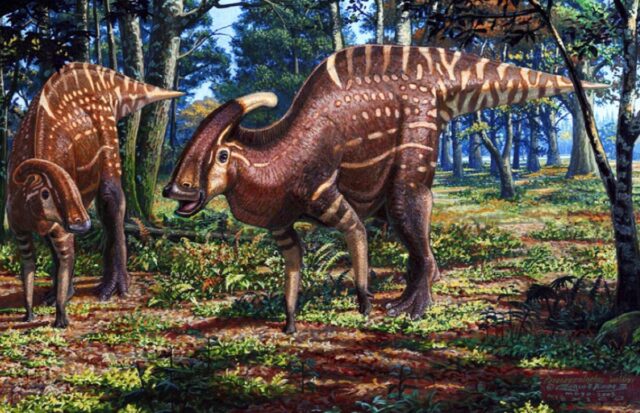We’re closer to re-creating the sounds of Parasaurolophus
A “near-crested lizard”

The most intriguing hypothesis is that the crest served as a resonating chamber, first proposed in 1931 by Swedish paleontologist Carl Wiman, who noted that the crest’s structure was similar to that of a swan and thus could have been used for vocalization. Lin stumbled upon a 1981 paper by David Weishampel expanding on the notion, predicting that the dinosaur’s calls would have fallen in the frequency range of 55 to 720 Hertz. Weishampel’s model treated the crest as an open pipe/closed pipe system. Lin did a bit more research, and a 2013 paper convinced him that Weishampel’s model was due for an update.
Lin created a physical setup to empirically test his own mathematical model of what might be happening acoustically inside Parasaurolophus‘ crest, dubbed the “Linophone,” although it is not a perfect anatomical replica of the dinosaur’s crest. The setup consisted of two connected open pipes designed to mimic the vibrations of vocal cords. Lin conducted frequency sweeps using a speaker to generate the sounds and recorded the resonance data with microphones at three different locations. An oscilloscope transferred that data back to his computer.
He found that the crest did indeed seem to be useful for resonance, similar to the crests in modern birds. “If I were to guess what this dinosaur sounded like, it would be a brass instrument like a huge trumpet or saxophone,” said Lin, based on the simple pipe-like structure of his model. However, the presence of soft tissue-like vocal cords could mean that the sound was closer to that of a clarinet.
Lin is still refining his mathematical model, and he thinks he should be able to extend it to studying other creatures with similar vocal structures.”Once we have a working model, we’ll move toward using fossil scans” to further improve it, Lin said, although he noted that one challenge is that soft tissue like vocal cords are often poorly preserved. His ultimate goal is to re-create the sound of the Parasaurolophus—and perhaps even design his own accessible plug-in to add dinosaur sounds to his musical compositions.
Source link
